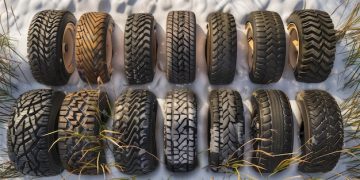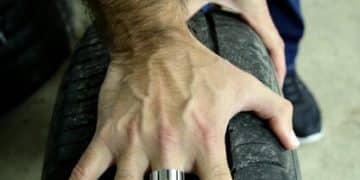Gas-saving tips for long-distance driving

Gas-saving tips for long-distance driving include planning your route, maintaining proper tire pressure, practicing smooth driving habits, and limiting extra weight in your vehicle to enhance fuel efficiency.
When it comes to long trips, gas-saving tips for long-distance driving can make a significant difference in your budget. Have you ever thought about how small changes can lead to big savings? In this article, we’ll dive into effective strategies to help you maximize fuel efficiency on your next adventure.
Plan your route for efficiency
Planning your route effectively is essential for saving gas during long-distance drives. It allows you to avoid unnecessary detours and reduces overall fuel consumption. Let’s explore some strategies to help you plan your route for maximum efficiency.
Use Navigation Tools
Today’s technology makes route planning easier than ever. GPS devices and smartphone apps can provide real-time traffic updates, ensuring you avoid congested areas. Consider using tools like Google Maps or Waze, which calculate the most efficient paths.
Consider Road Conditions
Before hitting the road, check the weather and road conditions. Adverse weather can slow your journey, causing you to use more fuel. Another critical factor is elevation; driving in hilly areas often requires more energy.
- Check for road construction that may lead to detours.
- Be mindful of high-traffic times when selecting your departure.
- Look for scenic routes that may be more enjoyable but still efficient.
Additionally, where you stop matters too. Plan your breaks at locations that are easy to access without significant detours. This not only helps you save gas but also keeps your journey smooth.
Finally, think about the overall length of your trip. Sometimes, a longer route can yield more significant savings thanks to fewer stops or less traffic. Understanding your destination and stopping points can lead to a more efficient journey.
Maintain proper tire pressure

Maintaining proper tire pressure is crucial for maximizing fuel efficiency during long-distance driving. When your tires are correctly inflated, your vehicle performs better, and you save on gas. Let’s look at why tire pressure matters and how to keep it in check.
Impact on Fuel Economy
Driving with under-inflated tires can increase your fuel consumption significantly. When tires are not inflated to the recommended level, it can lead to greater rolling resistance. This means your engine has to work harder, consuming more fuel in the process. In fact, appropriately inflated tires can improve your fuel efficiency by up to 3.3%.
Checking Tire Pressure
It’s easy to check your tire pressure. You can use a simple tire pressure gauge, which is available at auto parts stores. Here’s how to do it:
- Check your tire pressure when the tires are cold for the most accurate reading.
- Refer to your vehicle’s manual or the sticker on the driver’s side door for the recommended tire pressure.
- Make sure to check all tires, including the spare, if applicable.
Regularly checking the tire pressure should be part of your routine maintenance. Aim to check it at least once a month or before long trips. Keeping tires properly inflated not only helps save gas but also increases tire lifespan and enhances handling.
Remember, temperature changes can affect tire pressure as well. For every 10-degree drop in temperature, tire pressure can decrease by about 1 PSI. Therefore, be extra vigilant about checking tire pressure during seasonal changes.
Practice smooth driving habits
Practicing smooth driving habits is crucial for conserving fuel during long-distance drives. When you drive smoothly, you use less gas, which saves you money and reduces your carbon footprint. Let’s explore several key techniques to help you drive more efficiently.
Avoid Rapid Acceleration
One of the biggest contributors to high fuel consumption is aggressive driving. Rapid acceleration not only wastes gas but also puts unnecessary strain on your vehicle. Instead, accelerate gently and maintain a consistent speed. This approach helps improve your overall fuel economy.
Maintain a Steady Speed
Keeping a steady speed, especially on highways, maximizes fuel efficiency. Use cruise control where it’s safe and appropriate. This helps you avoid unnecessary speed fluctuations and keeps your engine running optimally.
- Set your cruise control on flat terrain to help maintain speed.
- Avoid sudden stops or sharp turns, which waste fuel.
- Shift smoothly between gears in manual cars to maintain momentum.
Another aspect of smooth driving is anticipating traffic. Look ahead and anticipate the flow of traffic. If you’re approaching a stop, ease off the accelerator instead of braking suddenly. This not only saves gas but also adds to your safety on the road.
Lastly, incorporate proper use of your vehicle’s features. Utilize air conditioning wisely, as running it can increase fuel consumption. Open windows at lower speeds for fresh air, and rely on air conditioning at higher speeds when windows are less efficient.
Limit extra weight in your vehicle

Limiting extra weight in your vehicle is a key factor in improving fuel efficiency during long-distance drives. The more weight your car carries, the harder the engine has to work, which uses more fuel. Let’s explore how to reduce unnecessary weight and save gas.
Clean Out Your Car
One of the easiest ways to limit weight is to regularly clean out your car. Remove items that you don’t need for your trip. Each pound can make a difference, especially when it adds up. Consider these common items to check for:
- Sports equipment you don’t plan to use.
- Unnecessary tools or gear in the trunk.
- Extra clothes or luggage not required for the journey.
Additionally, you should avoid keeping heavy items in your vehicle that you rarely use. This could be anything from old books to emergency supplies that aren’t necessary for your trip. The lighter your car, the better your fuel economy.
Be Mindful of Roof Racks
If you’re using a roof rack or cargo carrier, remove it when not in use. Roof racks create additional aerodynamic drag, which can decrease fuel efficiency, especially at higher speeds. Whenever possible, keep your vehicle as streamlined as possible.
Also, be aware of how extra items can affect your vehicle’s performance. For example, a full trunk can lower gas mileage by forcing the engine to work harder. Be strategic about which items you bring on your trip, ensuring everything is necessary for your journey.
FAQ – Frequently Asked Questions about Gas-Saving Tips for Long-Distance Driving
How can I improve my fuel efficiency during long trips?
You can improve fuel efficiency by planning your route carefully, maintaining proper tire pressure, practicing smooth driving habits, and limiting extra weight in your vehicle.
What is the benefit of maintaining proper tire pressure?
Maintaining proper tire pressure reduces rolling resistance, improving your vehicle’s fuel economy and extending the life of your tires.
Why is it important to limit extra weight in my vehicle?
Limiting extra weight helps your engine work less hard, which can significantly increase fuel efficiency during long drives.
What driving habits can save me gas?
Smooth driving habits, such as avoiding rapid acceleration and maintaining a steady speed, can help save gas and improve safety on the road.





